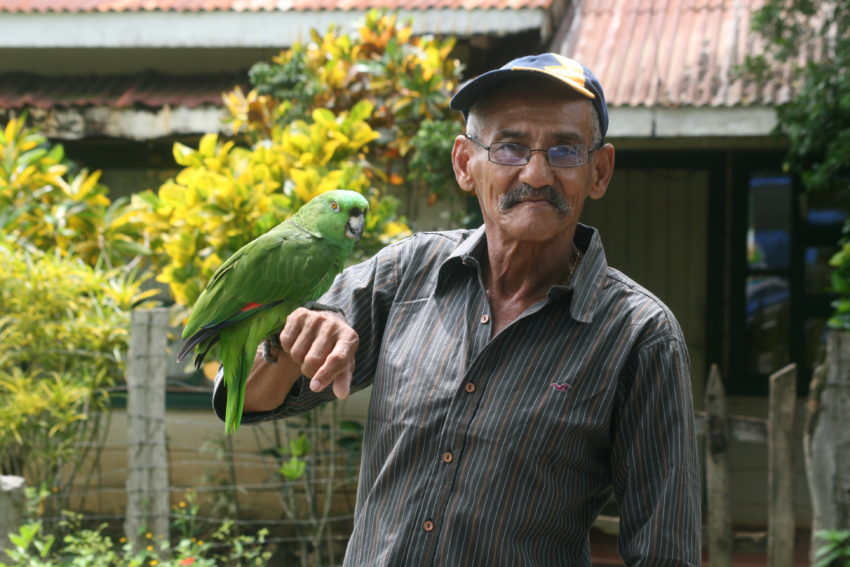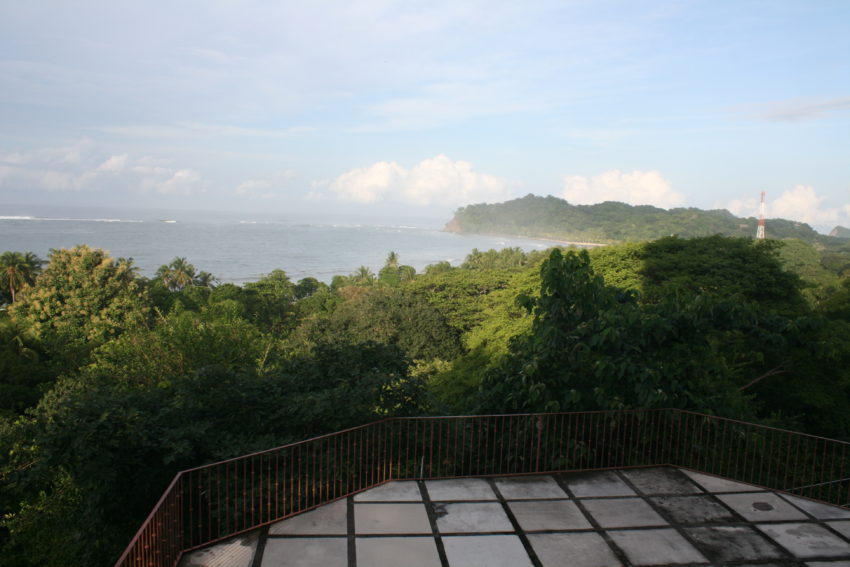Costa Rica Journal: Arriving in expat heaven on the Denver-San Jose Red-Eye Express

SUNDAY, JULY 14 – SAMARA, COSTA RICA
Apartment living is a great way to see Third World countries. Or, maybe this apartment is a great way to see Costa Rica. I’m sitting in a spacious, tiled living room with wrap-around windows that perfectly frame the Pacific Ocean. Yes, it seems like it’s the whole Pacific Ocean. The windows are that big. A hillside of palm trees and fruit trees cascade down from the languid infinity pool all the way to the sandy beach. This morning I could hear monkeys in the trees going “ka-ka-ka-ka.” It sounded as if they were tapping on the window. I’m in Samara, a small, lazy beach town of 2,200 laid-back, friendly souls on the Nicoya Peninsula.
The Nicoya Peninsula is shaped like a muscular forearm and fist and represents the northern half of Costa Rica’s long Pacific Coast. Lined with golden beaches, small towns and adequate infrastructure, it has been the trendy retirement destination for Americans since the 1990s. Real estate was cheaper than anywhere livable in the United States and a peaceful political climate made it a safe respite in between the occasional power kegs of Panama and Nicaragua. More than 50,000 Americans live in Costa Rica, according to the State Department, and the vast majority made beelines to this coast or the boring, ugly capital of San Jose.
The U.S. exodus began in the ’90s when they discovered the numerous long, sandy beaches, cheap prices and peaceful political climate. When I first came here in 1996, I spent my first four days in Tamarindo, a prototype backpacker beach town with a half-moon bay surrounded by sandy, palm trees and a few cheap hotels. I spent my days sunning on an empty beach, eating fresh seafood in one of the three restaurants, none of which I recall having a real floor, and sleeping in a simple bungalow next door. The closest thing I saw to package tourists was a VW van full of Canadians doing a tour of – and I’m not making this up – Latin American brothels. I couldn’t believe I actually shook their hands when I met them.

Today, the list of Tamarindo’s hotels in Lonely Planet fills two pages. It has resorts. It has a casino. It has a lot of Americans who can’t pronounce “Gracias.” It has been renamed Tamagringo. Or Scamagringo, depending on what Costa Rican, or Tico, you talk to.
Samara (pronounced (SAM-ara) is different. Walking along the beach for the first time, it brought memories of the Tamarindo I loved and the image I won’t let go away. Samara’s beach is a long, arcing stretch of gray sand with just enough beached driftwood to remind you that you’re nowhere near a five-star resort. Yeah, the sand is gray. You want white sugar sand, go to the Caribbean or Cuba. This is the Pacific, Jack. It’s a little more rugged over here but not under your feet. With virtually no maintenance, I saw hardly any stones. You could jog barefoot for miles and never suffer a cut.
The beach is spotted with the kind of laid-back beach bars you see in beer commercials. A few wooden tables in front of small wooden shacks. Some padded chairs under an umbrella, all facing out to the sea with dark-skinned, young, smiling waitresses serving ice-cold beers and ceviche. The biggest businesses on the beach are a couple surf shops with surfboards hanging like shingles outside a law office. In front of each one, a woman in a bikini or a long-haired surf instructor is half comatose in a comfy chair or hammock, waiting for the next customer or wave.
My kind of town, my friends. My kind of town.
Getting to Costa Rica from Denver seems easy but it’s grueling. As testament to the shuttle that has become U.S. to Costa Rica, Frontier actually has direct flights from Denver to San Jose. It takes only five hours. During the summer, we share the same time zone. The catch is my cheaper flight left just before midnight. Red eye flights are convenient if you actually have time to sleep but five hours is a misnomer. By the time they read the announcements, gave us weather conditions in Costa Rica, told us what’s on Frontier’s larcenously priced snack menu, pointed out Texas landmarks (which is always helpful after midnight), it’s past 1 a.m. Then, if you didn’t know, since 1978 there has been a FAA regulation that requires all screaming children under the age of 3 to sit within one row of John Henderson. By the time the demon child finally quieted down, it was past 2. The lights come on at 4 because, you know, it takes an hour to fasten your seat belt and prepare yourself for the landing.
I stumbled out of San Jose’s airport at 5 a.m. on two hours sleep. I took a cab to the downtown bus station which makes Denver’s Greyhound station in LoDo look like the private airport in Monaco. I had a cold orange juice sitting on a crumbling chair in the station’s snack bar, called a “soda” in Costa Rica, and waited for my bus with some sleepy Ticos catching up on morning gossip and a half dozen newspaper hawkers. At least I know where my newspaper industry is thriving. Wonder if Costa Rica ever needs a figure skating writer.
I had to take two buses to Samara and both reminded me I was in the Third World, way away from the gringo expats in Tamarindo. I don’t think any of them ever boarded a bus with no air-conditioning and their backpack resting on their legs which would otherwise be pinned against your chest. The seats are built for tiny Ticos, not 6-3 Americans like me.
However, a drive through the Costa Rican countryside is worth the money you don’t spend on an expensive transfer van. Traveling north through the heart of the country, I passed lush, green hills, well-maintained wood-framed houses. Palm trees were everywhere. I saw no beggars. No one slept in the village streets. This is what attracts everyone. Costa Rica is a Third World country desperately trying to move up in the world and, a lot of times, does a pretty good imitation.
Even the bus stations are fairly organized. I changed buses in Nicoya, about 40 miles northeast of Samara. Cyclone fences covered the ancient, wooden station. An old woman in a tiny ticket booth sold me a ticket while I fended off a crazy man trying to help me, with one eye staring at me and the other one pointed somewhere toward Nicaragua.
The hour-long ride to Samara offered a glimpse of what Costa Rica has always been. A boy in a straw hat rides a horse along the side of the road. Steers graze in lush farmland with steep green hills as a backdrop. Gates surround large houses front massive horse ranches. Roosters peck away in a soccer field that wouldn’t look out of place in Highlands Ranch.
Costa Rica … people do move here for a reason.

